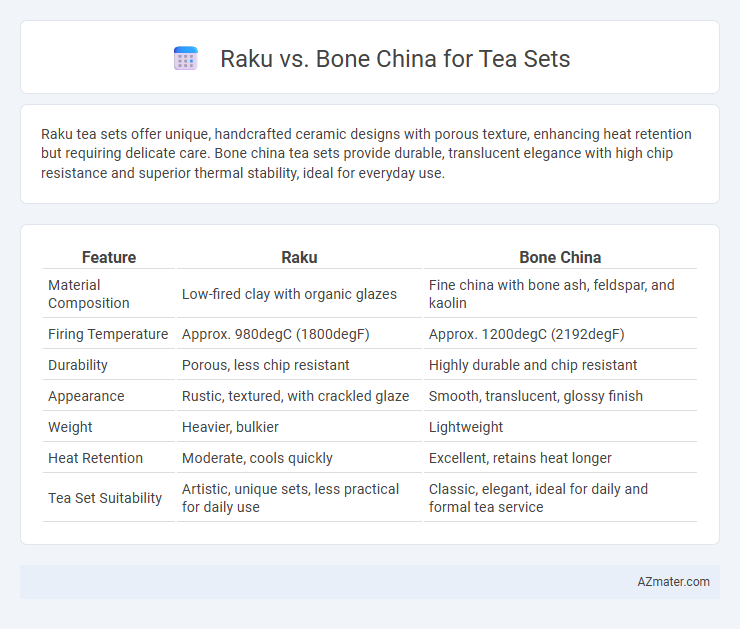Raku tea sets offer unique, handcrafted ceramic designs with porous texture, enhancing heat retention but requiring delicate care. Bone china tea sets provide durable, translucent elegance with high chip resistance and superior thermal stability, ideal for everyday use.
Table of Comparison
| Feature | Raku | Bone China |
|---|---|---|
| Material Composition | Low-fired clay with organic glazes | Fine china with bone ash, feldspar, and kaolin |
| Firing Temperature | Approx. 980degC (1800degF) | Approx. 1200degC (2192degF) |
| Durability | Porous, less chip resistant | Highly durable and chip resistant |
| Appearance | Rustic, textured, with crackled glaze | Smooth, translucent, glossy finish |
| Weight | Heavier, bulkier | Lightweight |
| Heat Retention | Moderate, cools quickly | Excellent, retains heat longer |
| Tea Set Suitability | Artistic, unique sets, less practical for daily use | Classic, elegant, ideal for daily and formal tea service |
Introduction to Raku and Bone China
Raku pottery, originating from 16th-century Japan, is renowned for its handmade, low-fired ceramics featuring unique crackled textures and organic finishes ideal for tea sets emphasizing rustic aesthetics. Bone China, developed in 18th-century England, combines bone ash, feldspathic material, and kaolin to create a highly translucent, durable, and smooth ceramic perfect for refined tea service. Compared to Bone China, Raku offers a more artistic and tactile experience, while Bone China emphasizes elegance and resilience in tea ware.
Historical Origins of Raku and Bone China
Raku pottery originated in 16th-century Japan, closely tied to the traditional Japanese tea ceremony and Zen Buddhist aesthetics, characterized by hand-molded clay and rapid firing techniques. Bone China, developed in 18th-century England by Josiah Spode, incorporated bone ash to create a porcelain known for its high strength, translucency, and white appearance. The historical roots of Raku emphasize rustic simplicity and spiritual connection, while Bone China reflects the Industrial Revolution's advancement and Western luxury preferences in tea ware.
Material Composition and Making Process
Raku tea sets are crafted from hand-molded clay fired at low temperatures and rapidly cooled, resulting in a porous, rustic texture ideal for heat retention and unique aesthetics. Bone china tea sets incorporate bone ash, kaolin, and feldspar, fired at high temperatures to create a translucent, durable ceramic with a smooth, refined finish. The raku process emphasizes artisanal, unpredictable glazing effects while bone china production focuses on precision and strength, influencing durability and style in tea service.
Appearance and Aesthetic Appeal
Raku tea sets showcase a distinctive, rustic appearance with crackled glazes and organic textures that highlight handcrafted artistry, offering a wabi-sabi aesthetic. Bone china tea sets feature a smooth, translucent white surface with delicate, intricate patterns that exude elegance and refinement. The choice between Raku and bone china hinges on whether the desired aesthetic leans towards earthy authenticity or polished sophistication.
Durability and Longevity
Raku tea sets, known for their hand-crafted, porous ceramic nature, tend to be less durable and more prone to chipping compared to Bone China, which is renowned for its high strength and chip resistance due to its fine bone ash composition. Bone China offers greater longevity, maintaining its translucency and smooth finish even after years of frequent use, making it ideal for everyday tea drinking. Raku's aesthetic appeal suits decorative or occasional use but lacks the robust durability and long-term practicality exhibited by Bone China tea sets.
Heat Retention and Tea Flavor Impact
Raku pottery offers superior heat retention due to its thick, porous structure, keeping tea warmer for longer periods compared to the thinner, denser Bone China. Bone China, with its smooth, non-porous surface, minimally impacts the tea's flavor, preserving the delicate aroma and taste more effectively than Raku's slightly earthier influence. Tea enthusiasts seeking prolonged warmth may prefer Raku, while those prioritizing pure flavor clarity often choose Bone China tea sets.
Maintenance and Care Requirements
Raku tea sets demand gentle handling and immediate drying after use due to their porous nature and unpredictable glaze, which can be prone to cracking or chipping. Bone china is more durable and less porous, allowing for easier cleaning with mild detergents and dishwasher safety in most cases. Proper maintenance of Raku involves avoiding thermal shock and harsh chemicals, whereas bone china requires careful storage to prevent chipping while benefiting from stronger resistance to stains and scratches.
Cost Comparison and Accessibility
Raku tea sets, handcrafted with unique glaze patterns and a rustic finish, often cost more due to artisanal production techniques and limited batch runs, making them less accessible to mass markets. Bone china tea sets are typically more affordable and widely available, benefiting from industrial manufacturing and global distribution channels that lower overall costs. Buyers seeking premium aesthetics may invest in Raku, while those prioritizing cost-effectiveness and availability generally opt for bone china options.
Eco-Friendliness and Sustainability
Raku tea sets are valued for their handcrafted, low-energy firing process, which significantly reduces environmental impact compared to bone china production that involves intensive high-temperature kilning and raw material extraction. Bone china contains bone ash derived from animal bones, raising ethical and sustainability concerns, whereas Raku ceramics use natural clays and glazes, often sourced locally with minimal additives. Choosing Raku promotes sustainability through biodegradability and reduced carbon footprint, making it a more eco-friendly option for conscious tea drinkers.
Choosing the Right Tea Set: Raku or Bone China?
Raku tea sets offer a unique, handcrafted aesthetic with porous surfaces that enhance tea cooling and flavor absorption, making them ideal for traditional and artisanal tea ceremonies. Bone china tea sets provide a delicate, translucent finish with exceptional durability and resistance to chipping, perfect for elegant, everyday use and formal settings. Choosing between Raku and bone china depends on whether you prioritize artistic uniqueness and tea interaction or refined elegance and longevity.

Infographic: Raku vs Bone China for Tea Set
 azmater.com
azmater.com